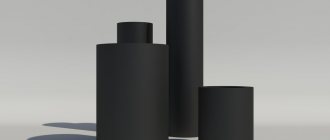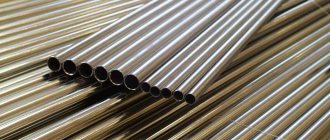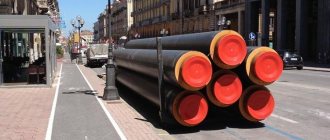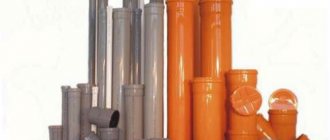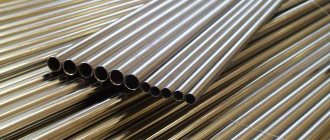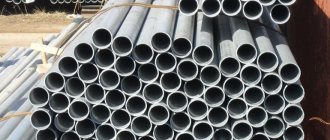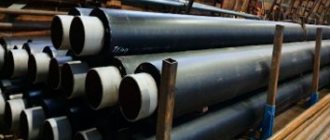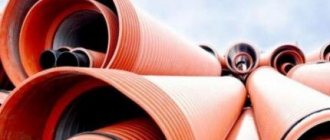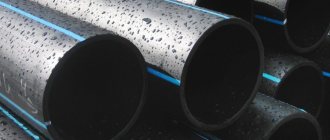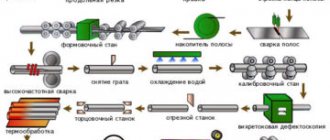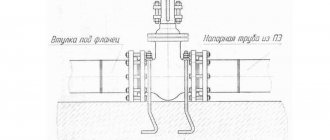But quite recently, for such construction, they used mainly variants of steel and cast iron.
Polymer pipes have come into use recently. They began to be produced simultaneously with plastic bags and bags, film for greenhouses, and so on.
Today, manufacturers even offer window frames made of polymers. All of the above are distinguished by reliability and long service life.
Many consumers question polymer pipelines, saying that colored coils resemble noodles, while the usual good-quality, thick and reliable cast iron ones look much more solid.
What do statistics say about this? European consumers install copper or polymer pipes in their homes. And only 20% of these consumers supply pipe products made from other materials.
To say whether a product is good or bad, you must first understand its characteristics.
It should be noted right away that the polymer is an organic substance that has all the disadvantages and advantages of natural high-molecular substances: leather, wood, wool.
Polymer in Russia
In our country there are more than eighty factories producing polymer blanks. They produce up to three hundred thousand tons of blanks per year. During the same time, these factories import up to 25 extrusion lines for the production of P pipes.
Conventionally, these manufacturers are divided into three categories: large, medium, and small. Price indicators have recently become more uniform, because consumers have begun to pay great attention to the quality of goods and the level of service.
And the range of these products requires expansion. It is for this reason that there are so many imported products of this series on our market.
Almost half of the imported goods are large-volume products. The thing is that the production of this type is associated with high quality standards and adherence to geometric standards. Among the Russian enterprises that have mastered this type of production are:
- "Klimovsky Polymer Products Plant";
- OJSC Kazanorgsintez;
- LLC "Borodino-plast"
Flexible and rigid products
Polymer blanks are divided into flexible and rigid, taking into account the level of cross-section deformation. With a low value of this indicator, products are classified as rigid; with a high value, they are classified as flexible.
Flexible pipes are used to work in small spaces; they do not wear out inside. When deformed, they take the shape of an oval, practically without changing their properties; when rigid, the shape does not change and is immediately destroyed.
The supplies are completed with fittings, special fittings and other equipment for installation.
Contact TK Flex for installation of Isoproflex and Casaflex. Check out the product catalogue.
Types of polymer pipes
The construction market presents the following main types of plastic:
- Polyethylene. (PE)
- Pex. (PEX cross-linked polyethylene).
- Metal polymers. This is a multilayer polymer pipe. It is classified as a complex structure consisting of 5 layers: cross-linked polyethylene, a layer of glue, an overlapping aluminum billet, a layer of glue, cross-linked polyethylene.
- Polyvinyl chloride.
- Polypropylene. Polymer reinforced pipes are considered the most stable and durable products of this type.
When talking about species, it is necessary to separately mention methods of protection.
For example, a bitumen-polymer pipe is a well-protected material from the effects of corrosion. It is covered with a special bitumen-polymer mastic.
They are successfully used in highways transporting natural gas, oil and petroleum products. Polymer coating of steel pipelines becomes an excellent protection for the outer surface.
What are polymer pipes made from?
Polymer pipes are made from materials obtained by polymerization of monomers. The main materials from which all pipes in the world are made are polyvinyl chloride, polypropylene, polyethylene and polybutene.
Polyvinyl chloride
White PVC pipes and fittings are usually used in sewerage systems. Gutters and manifold elements are made from it. They are not used for drinking water, since the molecule contains chlorine, which is dangerous to humans and the environment. They can be used for transporting technical liquids, for example, in water recycling systems and fire extinguishing systems.
Polypropylene
A material with high thermal resistance and low elasticity, it hardly bends, so pipes made from it can only be supplied in straight sections. This increases installation costs, since each joint requires welding in one way or another, costing materials and man-hours.
The advantages of polypropylene include chemical resistance, characteristic of all pipes made of polymer materials, affordability, and durability.
Polyethylene
Polymer pipes made of high-density polyethylene - HDPE (an outdated but generally accepted name is low-density polyethylene, HDPE) - are made from raw materials of the PE 63, PE 80, PE 100 brands. PE 63 is today used for free-flow pipes. PE 80 and PE 100 are used for pressure and non-pressure systems with high elasticity, durability, chemical and corrosion resistance. The downside of HDPE is the fear of the sun; with constant irradiation, the wall loses its elasticity and cracks.
Cross-linked polyethylene - PE-X, another type of polyethylene. Suitable for transporting water with temperatures up to 95°C.
Polybutene
The newest type of polymer materials for pipe production, with high long-term strength (MRS), low creep, high temperature resistance. Does not lose physical properties even when approaching the boiling point.
Polymer products for water supply
Pipes for water supply are produced in straight sections and coils of 100 and 200 meters. They have smooth surfaces.
GOST 18599-2001 is widely used in the installation and repair of water supply networks, in automatic watering systems, in the arrangement of swimming pools, etc.
They are divided according to the main parameters that influence the scope of use:
- Marking of the material used for production.
- Indicator of resistance to internal pressure.
- Diameter.
They come in black or black with blue longitudinal stripes.
Advantages and disadvantages of polyethylene pipes
Pipes made of cross-linked polyethylene have many advantages that distinguish them from other types of pipes intended for heating systems, but at the same time they also have some significant disadvantages, the study of which is mandatory when choosing them. So, the primary positive aspects of using PEX pipes include:
- Heat resistance and strength. The ability to retain their shape and withstand high temperatures of coolants contribute to their widespread use in heating systems, which is the main difference from polypropylene and conventional polyethylene pipes;
- Non-corrosive. Due to their special structure, they are resistant to all types of corrosion processes, both surface and intrastructural, which cannot be said about copper pipes;
- No internal layers. Various types of growth do not form on the internal walls due to the transportation of aggressive media, which, as a rule, leads to a decrease in flow velocity and is typical for steel pipes;
- Automatic shape restoration. Due to any deformations, such pipes do not lose their shape and have the ability to both expand and contract to a standard diameter. This property is not typical for other types of pipes and that is why they are not afraid of low temperatures and mechanical stress;
- A light weight. Their weight is quite insignificant, which does not cause discomfort or inconvenience during delivery to the site and during installation work;
- Easy installation and high technological capabilities. The laying of such pipes can easily be done according to various patterns (loop-shaped, with many bends, etc.), and the use of fittings makes the manipulation of connecting pipes simply elementary and does not require welding, gluing and soldering work;
- Environmentally friendly. These pipes are made from absolutely environmentally friendly materials and are intended not only for heating systems, but also for the transmission of drinking water resources.
will lead to corrosion and poor functioning of the system
When choosing cross-linked polyethylene pipes, it is necessary, first of all, to compare the technical parameters of this heating element with the characteristics of the living space where they will potentially function. If characteristics such as pressure and temperature of the existing heating system exceed the threshold values of PEX pipes, it is better to abandon their use. But, as practice shows, such cases are extremely rare. Therefore, based on all of the above, we can say with confidence that PEX polyethylene pipes fully comply with modern conditions imposed by heating systems operating in the vast expanses of our country.
Pipe diameters
The diameter of polymer pipes is one of the important characteristics; it plays an important role in the construction of pipelines.
RBC. Miron Gorilovsky in the program “Tokarev. Case"
The volume indicator includes several values:
- Interior.
- Outer.
- Nominal.
- Conditional.
On domestic products, the external volume is indicated on the label, while foreign manufacturers indicate internal parameters.
The minimum diameter is 1.6 cm. Such products are used for laying water supply and heating networks.
With a volume of 6.3 cm or more they are used for sewerage, and with a volume of more than 12 cm (these are large-diameter pipes) they are used for installing a gas main.
How are they classified?
Modern technologies make it possible to produce several types of polymer products - pipes, various other connecting elements. They differ in the chemical composition of plastic materials and the presence of metal inclusions:
- Polyvinyl chloride (PVC) is a material that is distinguished from other types of polymers by its hardness and ring rigidity. Successfully used for installation of non-pressure sewer drains. Particularly durable material SN16 is the basis for the construction of underground communications. High resistance to pressure loads allows the use of large-diameter polymer pipes at depths of up to 12 m. Main physical characteristics:
- maximum pressure – 16 bar.
- maximum ambient temperature – up to 45 oC.
Available in unplasticized form.
- Polyethylene (PE) – used for laying underground pipe communications. Maximum depth is up to 16 m. The high elasticity of polyethylene allows it to be used for the manufacture of liners of various types. In addition, it is excellent for airless dustproof enclosure. The material, consisting of “cross-linked” molecules (labeled PE-X), copes well with exposure to temperatures up to 60 ° C.
Permissible pressure in plastic pipes at different temperatures
*
- Polypropylene (PP) – used in standard pipelines or pipelines with an aggressive environment (hot water). Similar to PVC, propylene has high ring rigidity. The main advantage of this material is its resistance to high temperatures. Therefore, polypropylene is actively used for the manufacture of water pipes.
- Metal-plastic (PEX-AL-PE) is the most popular material of all that is used in the manufacture of materials for water supply. Thanks to the combination of a polyethylene liner, reinforced aluminum gasket and the main shell, the products are extremely durable and lightweight. An ideal option for installing a home water or heating system.
- Polybutene (PB) is part of the group of polyolefin artificial materials. It has a much higher ductility index than polypropylene. Much more resistant to ultraviolet rays. The thermal conductivity index is very close to that which characterizes “cross-linked” polyethylene. PB products are an excellent material for constructing warm floor systems. At a pressure of 0.3 Megapascals and temperatures up to 70 °C, the service life of the material is 50 years.
| Index | Material characteristics | |||||||
| HDPE (PVP) | HDPE (PSP) | PVD (PNP) | PVC | PP | PB | PVDF | PA (plasticized) | |
| Density, g/cm3 | 0,94-0,96 | 0,93-0,94 | 0,91-0,93 | 1,4 | 0,91 | 0,92 | 1,78 | 1,1 |
| Yield strength, MPa | 20-30 | 15-18 | 10-12 | 50-56 | 25-28 | 17-19 | 57-60 | 35 |
| Elongation at break, % | 800 | 800 | 600 | 50 | 350 | 300 | 20 | 100 |
| Modulus of elasticity, MPa | 900 | 600 | 200 | 3000 | 1200 | 500 | 2000 | 800 |
| Linear expansion coefficient | 2 | 2 | 2 | 0,7 | 1,5 | 1,2 | 1,2 | 0,9 |
| Allowable stress, MPa | 50-63 | 50 | 25-32 | 100-125 | 50-63 | 80 | 160 | 100 |
Sewage pipes
Sewage pipes are made of complex polymer compounds, this guarantees reliability and durability.
Sewage pipes are available in different sizes: for large and small loads. Blanks with a diameter of 20 cm are installed in hotels, hospitals and other institutions, and for individual construction they are used with a diameter of 15 cm.
Pipes for external and internal sewerage. Recommendations from experts // FORUMHOUSE
Types of polymer pipes
Pipes made of polymer materials can have different purposes. The main ones are:
- for gas supply;
- sewer;
- for hot water and heating;
- for cold water;
- for cable laying;
- drainage perforated pipes.
All types have markings that indicate the purpose, provide information about the manufacturer, diameter, SDR, as well as the standard to which they comply. It is strictly forbidden to use polymer pipes for purposes other than their intended purpose, and especially to violate the temperature regime. At high temperatures, wear occurs quickly and the product will not last as long as it should. It is important to understand that wear occurs along the entire length, which means that if defects appear, the entire pipeline will need to be replaced at once, which is very expensive and can lead to interruptions in the supply of water, heat, and gas.
What can polymer pipelines transport:
- cold water – drinking and technical;
- gas;
- hot water;
- alkaline solutions (including detergents);
- suspensions and emulsions with a significant content of suspended matter;
- domestic and industrial wastewater;
- rainwater.
They are used in public utilities, industry, for water supply of residential buildings, social facilities, agriculture and other industries.
Installation of P pipe materials
Installation of polymer pipes is not difficult. Despite the fact that these materials are new to the construction market, a number of advantages quickly put these products in a leading position.
The initial stage of work is the development of a project, in the preparation of which it is necessary to take into account thermal changes.
Next, you need to select a machine for soldering these rolled pipes. If this is a one-time job, then it is better to rent such a device from a hardware store.
How are metal-polymer pipes marked?
The most popular among polymer products are metal-plastic. The marking of metal-plastic by different manufacturers has some differences. But they all must indicate:
- Manufacturing company.
- Certificate of conformity. The product was manufactured according to it.
- Design features of the product. The material used for production is marked with letter designations (for polypropylene - PP-R, for polyethylene - PE-R, for cross-linked polyethylene - PE-X).
- The pipe diameter (and wall thickness) is indicated in mm, its values range from 10 to 1200 mm. However, sometimes the diameter is indicated in inches.
- Nominal pressure. It means continuous water pressure (in kgf/cm2 (PN) or in bars) in the product at an external temperature of 20º C. The fifty-year warranty provided for the metal-plastic pipe means use exactly in the described conditions.
- Transportable environment.
- Date of manufacture, batch number.
It is strongly recommended that when laying metal-plastic structures, you always leave the markings visible. This will significantly facilitate maintenance and repair, because it will be possible to immediately determine what type of product was used.
Welding of these pipe materials
Welding creates a high-quality connection of the pipe line.
For this work you will need:
- Welding machine.
- Special cutter.
- Marker, tape measure.
- Liquid for degreasing.
Installation of polypropylene pipes. Cheap budget option.
Polyfusion welding. In this type of work, the workpiece and fitting are heated on the nozzles of the device, and then they are connected. For such work, you need to use a table that indicates the exact heating time of the parts.
Soldering with electrical fittings. The apparatus is prepared as in the previous method. Then the workpiece and parts are inserted into the electrical fitting and fixed there. The device and the electrofitig are connected with a special wire. To start working, press the “start” button, and the mechanism turns off automatically.
Cold welding. It is not used often. The essence of the work is the use of aggressive glue, which is applied to each of the elements being connected.
This work is not at all difficult and anyone can do it. The machine for welding plastic products is a simple device that is not at all difficult to operate.
Table of sizes and characteristics
| Pipe outer diameter, mm | Wall thickness, mm | Weight 1 l.m., kg | Package |
| Polypropylene pipe PN 20 SDR 6 (for heating, hot and cold water) | |||
| 20 | 3,4 | 0,172 | Sections of 3-4 m. |
| 25 | 4,2 | 0,266 | |
| 32 | 5,4 | 0,434 | |
| 40 | 6,7 | 0,671 | Sections of 4 m. |
| 50 | 8,4 | 1,05 | |
| 63 | 10,5 | 1,65 | |
| 75 | 12,5 | 2,34 | |
| 90 | 15,0 | 3,36 | |
Some installation features
Installation of plastic sewer pipes
- The ease of laying polymer blanks makes these products very convenient to use. The workpieces are cut using small scissors, and this can be done directly at the site where the pipeline is laid. Large volume pipes can be cut with an ordinary hacksaw.
- Bending these materials is also easy. And to this we must add the fact that bending can be omitted, because there are many different adapters that allow you to create any angle in the network.
- If small-volume pipes are melted using a welding machine, then melting may occur. After work, it is necessary to check the passability of the workpiece. This is done by supplying air. If there is a congestion, then such work must be redone immediately, otherwise it will create problems during the operation of the highway.
- After cutting the workpiece, the burrs on its end parts need to be removed. This can be done with a simple stationery knife.
- When performing the initial docking, you need to do it “dry”. Only 2/3 should easily fit into the pipe roll adapters, and then the entry is made using some force.
If you remember these tips, the result will only be positive. And pipe materials will serve reliably for a long time.
How are they made?
The main technology for manufacturing plastic pipes is extrusion. The method is implemented on modern complex complex devices - injection molding machines. The required amount of special spherical polystyrene plastic is loaded into the extruder and brought into a liquid state by heating. After this, the resulting mass is extruded into the working area of the metal base - the casting mold. The process of maintaining the required temperature and cooling time of polystyrene in the mold is controlled using electronic sensors.
In the production of pipes with a metal-reinforced base, special casting molds are used that make it possible to wind stretchable polymer fibers using a special metal core. Cooling of the binder material is carried out using the forced polymerization method. Continuous winding is convenient because it can be used to endlessly vary the length of the finished pipe.
Polymer and drainage network
The most practical option for removing sediment from the roof is considered to be external drainage. The drainage network is made from a wide variety of materials.
Most often, drain pipes made of galvanized steel with a polymer coating are used for this purpose. These products last a long time and give the house an attractive appearance.
A new type of blanks - flexible
All types of polymer blanks are conventionally divided into: rigid and flexible. This indicator determines the degree of deformation of the workpiece in the cross section.
Soldering polypropylene pipes, technology, tools
If it is small, then the workpiece is classified as a rigid product. If it is high, then it is included in the flexible options.
Flexible pipes have been sold on the domestic market for a couple of years now. The leading manufacturers of these products are European companies.
This building material allows work to be carried out in difficult conditions of dense urban areas. These options include all PE blanks with a small volume.
Such products do not wear out at all on the inner layer, unlike a hard product made from classic material.
And this is not the only advantage of this option. Rigid products under increased loads do not become oval-shaped, but burst and collapse. Flexible ones, even with a deformation of 50%, do not lose their properties.
Flexible double-wall corrugated pipe DKS
Speaking about the use of materials of this type, it should be noted that European companies have developed not only a flexible polymer-metal pipe, but entire systems of such heat conductors.
The concept of a system in this situation includes: fittings, components and special equipment for laying such a pipeline.
Polymer transformed into a profile
The usual pipe shape is round, but there are also products that have a different cross-section (square or rectangular). Such blanks are produced by extrusion. This is how polymer profile pipes are obtained without seams and with different types of shapes.
The use of pipe products of this type is slightly different from the analogues described above. They are rarely used for drainage networks, but are widely used for insulating cables and electrical networks.
Production of profile pipes
The profile blank has significantly higher rigidity than round versions, which is why it is used for installing wires and external ventilation equipment.
Very often, profile polymer tubes began to be used in the construction of the frame of a veranda or gazebo.
Such great popularity of this type of pipe rolling materials is due to their wide range of positive characteristics and a small number of disadvantages.
Polymer pipe as insulation of a metal blank
Recently, they have become often used to insulate and protect metal workpieces.
These actions are dictated by a logical decision, because metal polymer coatings can protect from many things.
Such blanks can be used:
- For the network supplying hot water, because these preparations reduce heat loss during transportation.
- If such pipes are used for a network that supplies cold water, then you don’t have to worry about condensation appearing.
- There is practically no noise during the operation of such a pipe line, thanks to the insulation.
- If the line is laid in the ground or wall, then you don’t have to worry about it being damaged by corrosion.
- Such products are not afraid of abrasive wear, which leads to their destruction.
Separately, it is necessary to highlight the advantage of polymer insulation in terms of resistance to chemical reagents.
Because any metal workpiece cannot withstand such influence. Such protection extends the service life, and this is very economically beneficial.
Back to the Future
It is worth noting that steel and cast iron manifolds cannot be completely replaced. Most of them run under city roads, and their replacement requires not only a colossal amount of time, but also very high costs. The construction of a new collector may involve the relocation of other communications - the cables also run underground, and also require costs for landscaping the area after the repairs are completed.
What's being done today? New sections, where possible, are made of polymer materials, and where repairs are required, the section is rehabilitated or completely replaced with polymer pipes. The installation technology allows the connection of polymer pipes with pipes made of other materials, and this allows you to combine old and new with maximum efficiency.
